Full children's schedule will resume 9/17
September 11th, 2007Summer is coming to an end, folks.
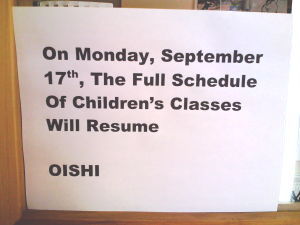
Summer is coming to an end, folks.

I saw that Sensei posted some upcoming dates on the window of the dojo office, so I thought I'd post them here as well, with links to some of the events. You'll have to ask Sensei for details on the others, because I got tired of Googling for them. It baffles me that it's so hard to find an official web page for some of these events.
| Date | Event |
|---|---|
| Oct 6-7 | East Coast Championship, Newark, NJ Entry form: PDF or Word format |
| Oct 13 | Hudson Promotional Shiai, North Bergen, NJ Entry form |
| Oct 19-21 | U.S. Open, Gwinnett, GA Info and forms (see links under "Coming Events") |
| Oct 27 | Referee Clinic, Brooklyn, NY Cancelled, according to this |
| Oct 28 | Kata Clinic, Brooklyn, NY Application |
| Nov 4 | Tech Judo Shiai, North Bergen, NJ Info and form (click on "events") |
| Nov 17 | Kata Exam, North Bergen, NJ Application |
| Nov 18 | Cranford JKC Shiai, Cranford, NJ |
| Nov 25 | Nakabayashi Shiai, New Rochelle, NY |
| Dec 2 | Northeastern Invitational, Paterson, NJ |
Update: Tech Judo now has info on their site. Thanks to Jeff for the heads-up.
Update: Hudson Judo has put up an application form for the 10/13 promotionals.
Update: Jeff sent me a corrected date for the kata clinic. Hudson Judo has put up the application form for the clinic, which is 10/28, and for the exam on 11/17.
I just learned from my buddy Hiro that several of my YouTube videos can be viewed on the iPhone (which means they'll also work on the new iPod touch). Below is a picture of my iPhone after I a did a search for "Oishi judo." The top two results are among my favorites: a highlights reel of the dojo tournament in February, and one short match from that tournament, in which John Harris threw Alex Hon with a nice counter that got a reaction from the crowd.
YouTube has been converting their entire collection of videos to the format used by the iPhone. They have millions and millions of videos, with tens of thousands being added every day, so this is a huge undertaking. They expect to be all caught up in October — hopefully in time for the videos I'll take at the East Coast and Hudson Promotional tournaments.
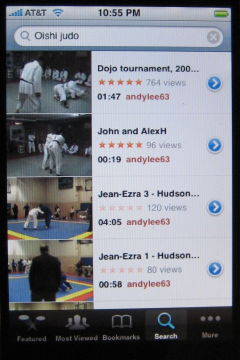
The old soda machine is alive and well. Back when the dojo was moving, some of my coworkers brought the machine from Leonard St. to our offices at Broadway and Spring.
Sensei got us started by loading the machine onto a handtruck and pulling it up those narrow, twisting stairs to the floor above, with a couple of guys pushing from the bottom. He was supposedly showing us how we should get up the stairs, but ended up doing the job himself. We then put the machine in the freight elevator, took it to street level, and loaded it into a waiting truck.
Thanks to Scott, Dan, and the other Scott for bringing muscle and transportation, and thanks to Pando for giving the soda machine a new home, where for all we know it will give us another 35 years of service.
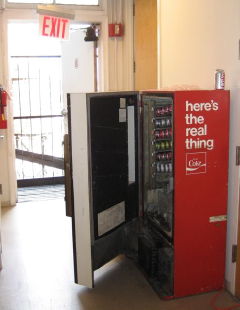
Jeff wrote me yesterday with the following:
In a book on aikido, it is suggested that the three key elements of aikido (and so, I would suggest, any martial art or sport) are confidence, center and balance. Then the proper distance (maai in Japanese), then grip (for judo or aikido, but not for a striking art) and then the throws, locks, pins or chokes.
Your reaction?
Note that I'm just an ordinary judo player, not a general martial arts expert. Also, I haven't read the book Jeff mentioned, which means I'm responding completely out of context.
I can think of a lot of "key elements" of martial arts. Many of them are closely related, and the words for them often have overlapping or multiple meanings. Not to mention, "martial arts" means a lot of very different things to different people. I think trying to make a top-N list is an endless exercise — but not necessarily worthless. So here are the first two things I would have said.
For the number one thing, I wouldn't have said confidence so much as awareness, both inner and outer: knowing where you are, knowing what's going on around you, knowing your physical health and your state of mind, sensing the intentions of your opponent or opponents, and, very importantly, being able to keep up with changes in all the above as fast as they happen. Maintaining awareness in real time has to do with reflexes, and with your predictive abilities (based on experience), and it has to do with not overthinking, because if you think too much about what's happening now, you won't be able to keep up — it'll happen too fast.
In randori, I've noticed I'm not as aware as I used to be. Things happen that I don't see or feel coming, or if I do sense them, I get sort of befuddled by them. I think part of it is that I'm just older and my reflexes are naturally slower. At the same time, because I am older, people are playing me harder than when I was a kid. But I think there is an aspect I can improve. I think I've been charging in lately and thinking too much of imposing my will, without opening my senses to what my opponent is doing. Will Heinrich has described good randori as a kind of conversation. I think I haven't been a good listener lately in that conversation, and that's something I can work on. If nothing else, I should work on being aware of the other people playing randori, so we don't crash into each other. I used to be better about that too.
For the second "key element" of martial arts, I might have said "liveliness." In order to keep up with rapid change, your awareness has to be active, not passive — it could almost be described as a constant curiosity about your surroundings. In addition to liveliness in taking in information, you have to have a drive to express yourself in your outward actions, whether that self-expression means defending yourself against an attacker, performing a kata perfectly, or winning in shiai.
"Liveliness" could be described as "appetite." There's a great line in Enter the Dragon where Roper says, "A man's strength can be measured by his appetites. Indeed, a man's strength flows from his appetites." I have no idea whether that was Bruce Lee injecting real martial-arts wisdom into the script, or if it was just a catchy line meant to sum up Roper's character in a nutshell. But I liked it.
So if I were to advocate a martial-arts buzzphrase, it might be "lively awareness." Maybe somebody could argue, isn't that another way of saying "confidence and balance"? Then I might say that "confidence" is a tricky word, because it could be taken the wrong way: it shouldn't be a self-centered or misplaced confidence; it shouldn't be confused with bravado. And then somebody might explain that "confidence" (or whatever their number-one word is) is actually an imperfect translation of some Japanese word that means such-and-such.
What about compassion? Humility? Optimism? Tenacity? What about "beginner's mind"? What about that attitude that Sensei calls "happy face"? What about the two principles we judo players already have — mutual benefit and maximum efficiency? You can see how this could become an all-night discussion over dinner and beers.
No definitive answer will be reached. But as I said, I think it's worth thinking about this stuff from time to time, and besides, it's fun.
Using the "Street View" in Google Maps, I zoomed in on the photo below of our block on Greenwich St. Number 547 is the drab green storefront in the center:

I believe the photos on Google Maps are something like two years old, so this would have been how it looked just before we took over.
Now look at a recent photo:

Even accounting for the poor resolution of the Google Maps photo, you have to admit we've beautified the neighborhood.
This might be the laziest blog post ever. The following is copied from a post on my old blog, which I hardly ever update any more, though I get ideas now and then.
If you get a bad cut, you can hold it closed with a bit of egg membrane. If you crack a raw egg very carefully, you'll find a thin sticky membrane lining the inside of the shell. You can use pieces of this to make an X-shaped bandage across the cut. The membrane dries clear and eventually wears off. Besides holding the cut closed, I suspect because it is pure protein it promotes healing.
I learned this tip from a judo player named Jeff, who learned it from our sensei. One day Jeff got a gash on his forehead from an accidental head butt during judo practice. Sensei patched it up with the egg trick, and it held so well that when Jeff got to the hospital the doctor who stitched up the cut said he could probably have just left it. There is essentially no scar; you'd have to get up close and squint to see there was ever a cut there.
I did a little googling and found this is a good remedy for insect stings. I also learned that Lon Chaney used to put egg membranes on his eyeballs to make them look cloudy.
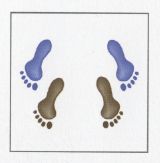
I don't remember when, but at some point I started thinking of small everyday movements as a kind of mini-uchikomi. For example, opening a heavy door: as I pull it open, I imagine pulling an opponent off-balance, and I try to keep a straight posture. Then I use my foot to "sweep" the door further open. I think this small habit helped me learn to do foot sweeps with my hips forward and my foot turned, and with a straight leg and tight inner thigh. Try it and you can see how it makes the movement stronger than if you bend at the waist, which most beginners instinctively do.
The other movements I can think of all relate to seoinage.
When I sit down in the subway, I approach the seat as if it's uke and I'm doing seoinage. I use the foot movement illustrated in the diagram above, which is from page 70 of Neil Ohlenkamp's Judo Unleashed. The blue feet are uke. I do a crisp turn to snap my feet into the desired position before sitting down.
When I pick something up from the floor, even something small, I squat instead of bending over. I squat straight down in kind of a dropping movement, as if there were an uke behind me and I wanted to "disappear" for a low seoinage. (Actually, to be honest, in recent years I've taken to bending over sometimes instead of squatting. It's not as easy to squat as it used to be.)
When I'm carrying a big laundry bag, I carry it on my left shoulder and grip the cloth with the small fingers of my right hand, as if I was about to throw the bag with left seoinage. The left side is my favorite, but I make myself switch to the right. Of course, this idea is nothing new. From what I understand, the basic hoisting movement of seoinage is related to the movement used to hoist a bag of rice on one's back.
As some of you know, I was away from judo for many years. During that time I still opened doors with a foot sweep. I don't remember if I kept the other habits as well, or if they only came back when I came back to the dojo. Now that I'm a real judo player again (rather than just a judoka at heart), I'm more conscious of little bits of judo in the way I move.
Sensei still has plenty of Oishi Judo patches. They are 3 inches in diameter and look great on the chest or shoulder of your judogi jacket. You can click the image on the right to see a closeup.
Five bucks each — a small price for looking sharp.
I've had three patches for weeks, and recently bought a fourth for my gym bag, but haven't gotten around to sewing any of them on. I should probably get my dry cleaner to do it instead of procrastinating on a job I'll probably botch anyway.
If you do try to sew a patch yourself, you might want to prewash it. I read somewhere this makes it easier to thread and also reduces shrinkage problems. I think I'll prewash mine even if I outsource the sewing.
Little known fact: last October, Nina brought a lemon tart for us to enjoy after the East Coast tournament. She made a decoration for it out of white and dark chocolate, based on the same Oishi logo that is on the patch:
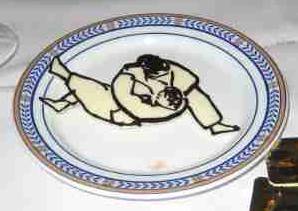
Last week's article in Downtown Express reminded me of a book called Chess For Fun and Chess For Blood, written by Edward Lasker and published in 1942. The book is a classic among chess players not only for its technical analysis, but for Lasker's lighthearted way of discussing the human side of the game: how chess players are wired and how they interact.
The most famous of Lasker's observations is of course the one in the title of the book. "Chess for fun" players are casual, recreational players. They may try a cute combination, even if it is technically unsound, just because it amuses them. They may try to crush each other on the board, but win or lose, they will have a good time. "Chess for blood" players, on the other hand, are deadly serious about winning their next tournament. Their preparations, not to mention the matches themselves, put them through intense psychological stress. Defeat is excruciating. Risking a match on something "cute" is the farthest thing from their minds.
I think judo players — and judo clubs — can probably be classified along similar lines. And what comes through in the Downtown Express article is that our club is above all a "judo for fun" club. I've taken hundreds of classes at Oishi Judo, and not one was without laughter. We get thrown, and we get up with a smile, though perhaps not as big a smile as the person who threw us has.
Sure, there are serious competitors among us, and people eager to earn their next promotion, and we all play judo partly to get strong and fit. But the overwhelming reason for us all to be there is the pure pleasure of it. We're there to play each other, not fight each other. No pressure, only encouragement.
I mentioned Lasker's book to Jeff the other night, and he reminded me that one of Sensei's signature phrases, "happy face," expresses perfectly what "judo for fun" is all about.